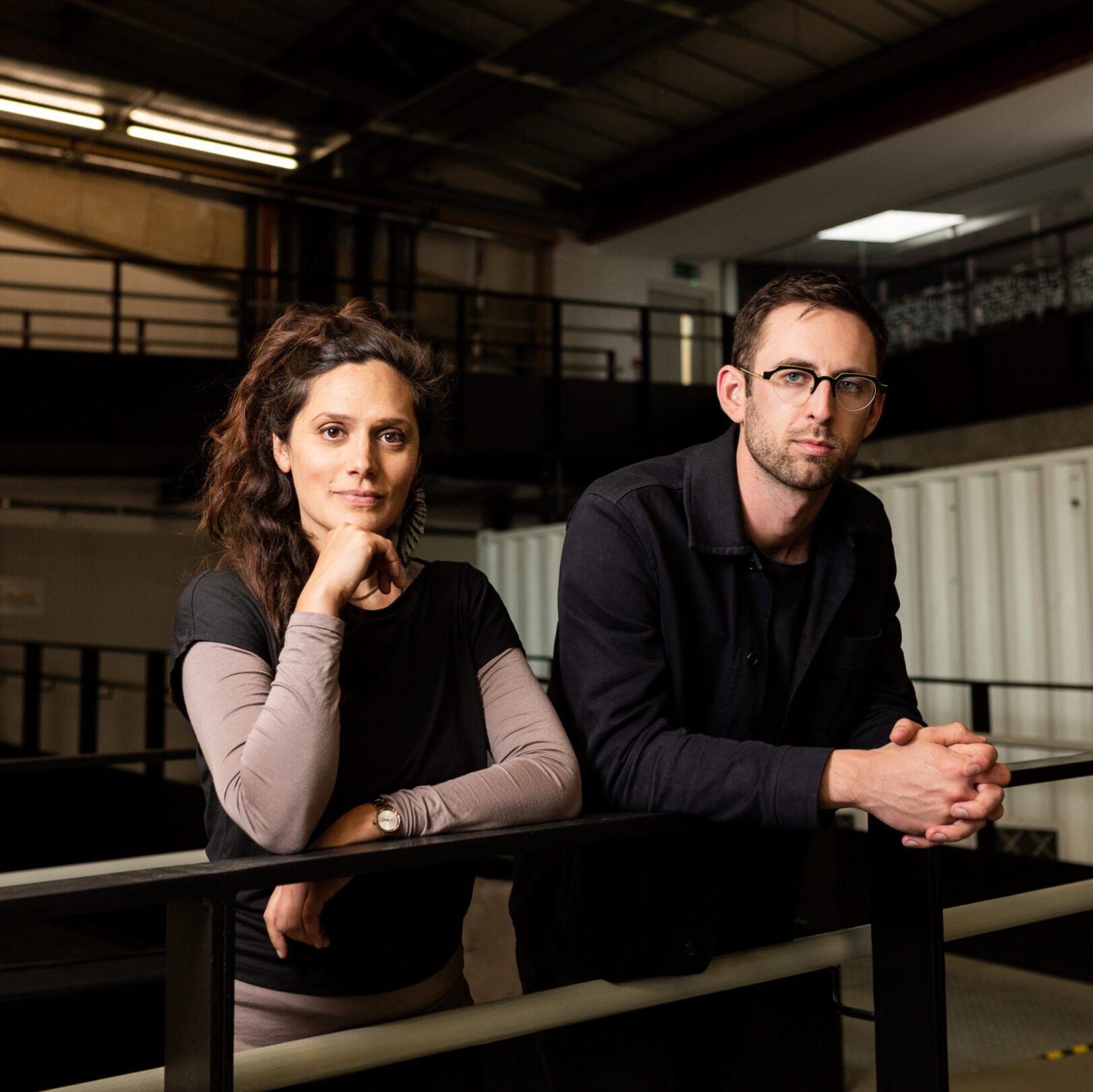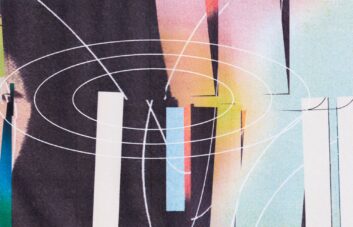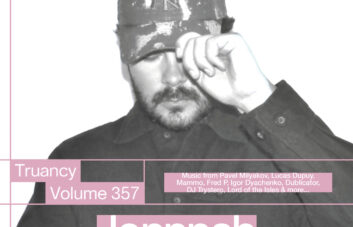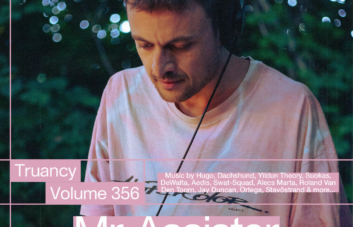It’s December 2021 and chamber group Manchester Collective are on stage at the Howard Assembly Room in Leeds, undercutting the pomp and posturing innate to all classical venues with their palpable enthusiasm and personable candour. They’re presenting a programme named Heavy Metal, looking to distort sound as well as the performance space itself. First on the setlist is Bruce Dessner’s Aheym, introduced as “a total workout – a sprint, into ballet, into sprint.” What follows is frantic dynamism between violins, viola and cello. It’s like watching a string quartet masquerading as a rhythm section play hot potato with sound, and it sets the perfect tone for the evening.
There’s Sebastian Gainsborough AKA Vessel’s reverent, spiritual composition, Squint, named for the gaps in architecture allowing for worshippers all across the church to see the alter directly. The centrepiece of the show is Ben Nobuto’s SERENITY 2.0, a metallic, glitchy muzak piece that channel hops between relaxing, time-passing elevator sounds and samples, ASMR, vaporwave and grind; the most jarring thing about this juxtaposition being the uncanny, absorbing sight of internet music being played with instrumentation. If there’s a climax in this programme, it’s Michael Gordon’s Industry. Written in 1992, it’s very contemporary and yet it’s the oldest piece in an exhibition where, somewhat unusually, all composers making up the programme are still alive. Its cello expands into something raw, monolithic and indeed industrial, its Ibanez Tube Screamer abrasions ascending towards the building’s fire alarm that starts ringing out. The musicians are so thrilled to perform that the percussionist can’t help but play along to the fire alarm, and the audience so enthralled by these sounds that they can’t help but stay and listen.
For six years now, Manchester Collective have been commissioning, performing and recording music this refreshing, this exhilarating, this intuitive. Its vision to create more experimental and extraordinary experiences within and beyond the world of classical has flowered under the stewardship of chief executive Adam Szabo and music director Rakhi Singh. As they look to showcase their new tour Neon across the UK in May 2022, featuring compositions from Lyra Pramuk, Julius Eastman, Steve Reich, Hannah Peel, Daniel Elms and Alexander Whitley, an interview brings the inspirations and alchemy fuelling their collaboration into focus: walking their own path between scenes, making space for their artists to create, and testing the fine line between creativity and chaos. Considering classical music journalist Bob Shingleton’s plea for more non-linearity across the genre in order to bring in new listeners and save it, there’s no better time for electronic and experimental music fans to grow their interest in contemporary classical music when there are acts as exciting and relevant as this.
Can you tell me a little bit about how Manchester Collective came about?
Rakhi: “It was actually [when] Adam and my sister met and were playing together, and realised the value of having a chamber collective, because often chamber groups are quite fixed. And so she introduced me to Adam and we thought, okay, let’s go for it. Having a blank slate meant we could program whatever the hell we liked to play, and could also decide where to play it. I guess at the beginning, there wasn’t much choice because people didn’t know who we were, so we had to start in the more underground venues and more alternative spaces anyway. But then, as we grew, concert halls were interested in what we were presenting as well, so now we do a mixture of both.”
Adam: “It’s interesting that that’s really been a constant through the work that we’ve done – you know, tonight, we start this tour for a new project called the Oracle, and we’re at a venue called Future Yard in Birkenhead, which is a really cool black box, rock-and-roll venue. It’s standing, everyone’s jammed in, it’s sweaty and dark, and then on the same tour, we’re playing Queen Elizabeth Hall on the 24th of April. Having these different kinds of venues side-by-side has always been really exciting, because that’s more unusual. You get a lot of classical bands that just go around playing concert halls or you get contemporary music acts or pop groups that go around playing arenas or gig venues or whatever it is. We find that the work changes so much depending on where you’re playing that that’s quite an exciting thing for the artists as well. And obviously you get completely different people turning up to the Southbank Centre than you do coming to Birkenhead, or the White Hotel, or Strange Brew in Bristol, or whatever it is.”
R: “It feels really valuable. You take things to different contexts and you’re reaching different people, and you are existing in a different way as a result of that.”
What does it mean to be able to take the music that you’re performing into these different spaces? Are there audiences coming to venues they wouldn’t necessarily do otherwise?
R: “Before we started doing it, we didn’t quite realise the ripple effects it can have. You get people who wouldn’t normally go to the White Hotel, and might go to Stoller Hall or Bridgewater, coming to the White Hotel. And actually, some people hate it, some people absolutely bloody love it and would rather see us in the White Hotel than in a concert hall. So already, there’s that crossover, which is even before we’ve played a note, really. That’s more to do with the architecture, the building and the feel. So then when we are playing the music, you’re experiencing it in a different way and that also makes us play differently, because we’re in different spaces. So we bring some of the freedom that we feel in the other spaces back into the concert hall. It becomes this incredible dialogue between buildings, between people, between art, and it’s all changing as a result of putting yourself in a different space.”
A: “There’s work that we play that is more at home, by default, in the concert hall, and then there’s work that we play that is more at home, by default, in those alternative spaces or gig venues. Some of the most interesting experiences that we’ve had are when [we’re] presenting the work out of its natural habitat. I guess Vessel is another artist that you wouldn’t normally expect to hear at the Howard Assembly Room. And then actually, if you bring in a big, old, beefy PA, and you can feel the sub in your chest in a venue like that, it’s a small thing but it can really subvert the expectations people have of what different spaces mean and what sort of work belongs in what different spaces. And likewise, we can play a string piece by Vivaldi at the White Hotel, which we have done – it brings that music into the present in a way that it can feel very removed from the present if you present it in a concert hall. With the more classical stuff, you’re quite violently ripping something out of its usual historical context. The one thing that classical music has generally tried to reinforce for hundreds and hundreds of years is that there’s always this really strict divide between performers and the audience. There’s a lit stage and a dark auditorium, and there’s a raised stage and a lower down auditorium. There’s all of these psychological barriers and then the first thing that happens if you go to, you know, Future Yard, Birkenhead or White Hotel or whatever it is, those lines are obliterated because people are setting their pint glasses on the side of the stage, jostling around, people all over the place. And so it’s very hard to feel like the classical repertoire is this removed thing in that environment.”
R: “If you think about the Rite of Spring premiere, where people were booing and throwing tomatoes, classical music hasn’t always been so removed. It’s somehow just ended up in this museum space rather than a space of dialogue and vitality. In that sense, maybe we’re just going back to how it was, bringing it back down to earth a little bit.”
This makes me think of a conversation the writer DeForrest Brown, Jr. and I once had, where we were discussing the white Western canon of experiencing music, which involves a situation where everything is on stage and the audience have to be strapped to their seats and are only permitted to receive the music in a very defined way. Whereas if I’m going to, say, an electronic music festival with something a bit more classical as part of the offering, I don’t feel out of place getting up and having a dance, moving to it. And I bet it’d be the same if I was at the White Hotel.
A: “You might struggle to find a space, that’s the only thing.”
But if I stood up in, say, the Howard Assembly Room, it can be a big deal, right? So when you’re performing the music, how much do you have the audience and the choice they have to experience in attendance?
A: “It’s absolutely at the heart of the work. A lot of the time, what we’re trying to find is a sense of discovery and a sense of the unexpected. With this show with Abel [Selaocoe] that we’re touring at the moment, he’s this South African cellist and a lot of the music is really up-y and built out of these folk traditions from South Africa. And bringing a kind of a raucous, chaotic energy to concert halls is a really interesting thing for us to be doing. And likewise, sometimes the ‘club’ shows are really wild, but we’ve played Shostakovich string quartets there, where you can really hear a pin drop. And it’s not that it’s a seated concert gig, the bar’s open, people are milling about, but there’s something about creating an atmosphere with some of this music where people just suddenly start holding their breaths because you’re dealing with so quiet, fine sounds. Then at the other end of the program, if you can create with some work that has a massive sound, then it’s just about a range of experience in every venue. We’re not big on codified ways of experiencing a performance. So in both directions, I think we try and subvert that.”
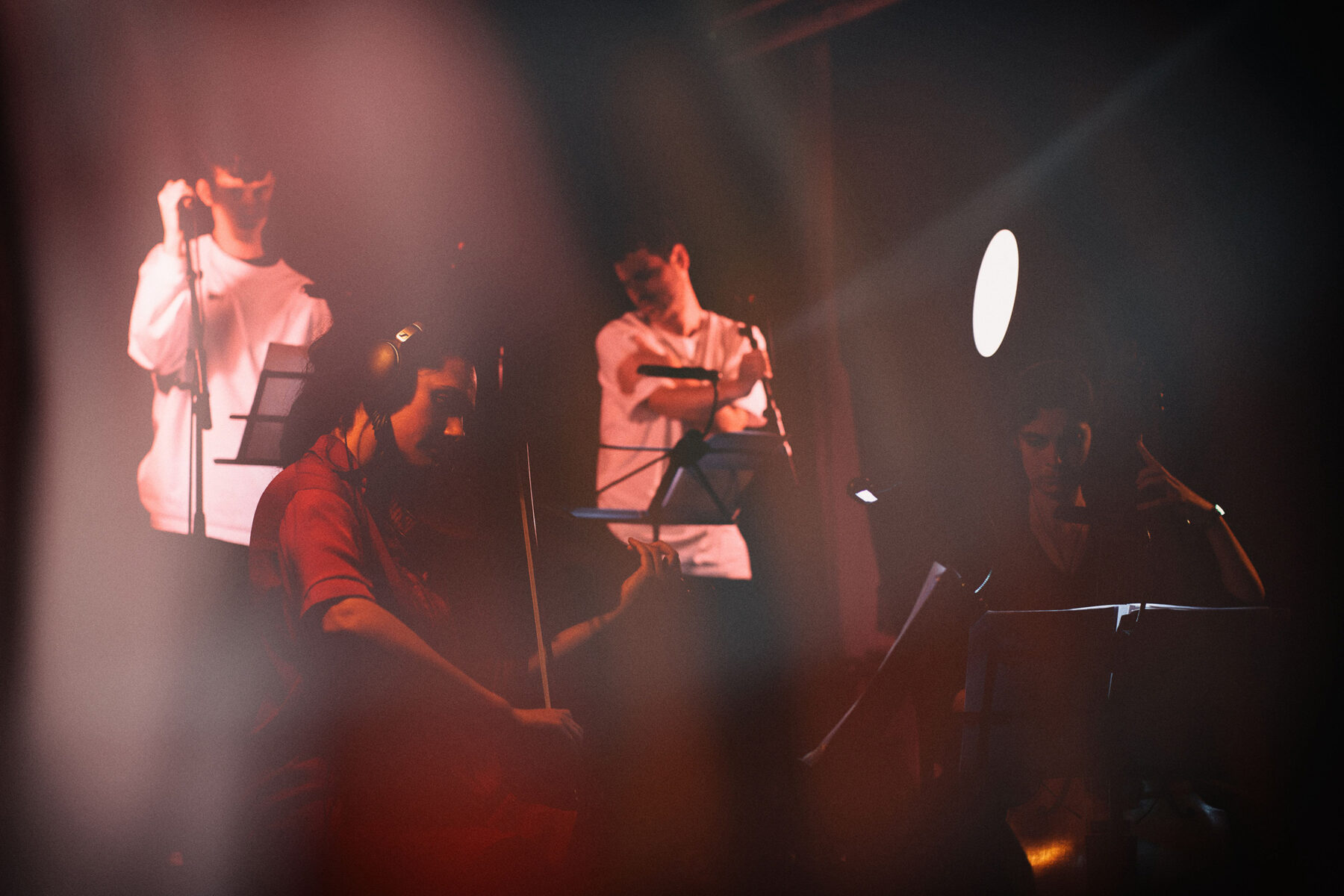
How do the venues feel about this? You’ll be working with some venues who maybe aren’t used to having these instruments come through their doors and take to the stage. I also wonder about the more classically attuned venues, how do they feel towards electronics and those frequencies?
R: “Well, we keep getting asked back. So it must be alright, they know what they’re in for. When we started the organisation, we said we’re going to follow our own path and people who like us will really like us and trust us. In that sense, people know what they’re letting themselves in for: not knowing what might happen. So they have to give us freedom in that sense.”
A: “I would say it’s actually easier in the, you know, rock-and-roll venues. We’ve brought grand pianos into these club spaces, which you think would be a crazy thing for them because they do electronic music so what’s a piano doing here? And that there’s five massive guys and a forklift and whatever. And actually, they’re always just like, ‘Yeah, cool. So what time do you need us to open the roller door?’ It’s always fine. The more difficult stuff tends to be more with the classical places, honestly. It’s usually stuff like, you know, we will have specced out a certain PA, for example, because there are these frequencies in the electronic stuff that we’re playing so we need this kind of PA. And then they’ll be like, ‘Oh, but surely the house system is fine? They used it last week for Hallé and James Bond!’ I literally had this conversation yesterday: They’re like, ‘It was great for the Hallé, they had a singer! It’ll be fine!’ You know? And then you’re like, ‘Well look, I’m sorry, but if the Hallé was coming to play for us, we wouldn’t tell them to replace five of the double basses with this extremely excellent electric bass and it will be just as good…’ I guess it’s that dialogue and understanding that the electronic or non-acoustic instruments involved in some of this other work, synths or whatever it might be, that needs as much care and attention. They’re really good at worrying about whether there’s enough space for the violas or not, and whether third trombonist see the conductor or if there are lights in the players’ eyes, but then, you can spec out three hazers and then they’ll be like, ‘Oh, well, we’ve got one and it will work half the time, but there’s your hazer!’ And it’s like, well, sorry, but this is part of the show, actually.”
R: “But that’s lack of knowledge and experience, isn’t it? I think in some ways, we’ve learned more about that as we’ve gone along as well.”
It’s nice, the idea that both parties have something to learn from through this sort of programming and collaboration. How long has the process taken to get to where you are now, able to walk in between these different types of venues and choose?
R: “We’re in our sixth year now. We had our fifth-year anniversary last December.”
Are you okay with the balance of where things are at, or are you looking to move in a specific direction?
R: “I think it’s going pretty well.”
A: “It’s really important we keep both. It has been interesting, it felt like there has been pressure on us to let go of some of the alternative stuff, because now we’re getting asked to come and play… I guess with live music, everything’s always about size, isn’t it? If you’re a major artist, then it’s really hard to go back to playing venues that are 150 cap because everyone stands to make much more money if you’re playing bigger venues. Certainly it would be much easier to be like, oh, well, we’re gonna do 500 to 600-seater concert halls and that’s going to be the average thing, but actually, Strange Brew or White Hotel, Future Yard, or you know, the Holbeck or whatever it is, they’re really artistically important for us and they inform a lot of the work that happens in the concert halls. I think we’re quite deliberately like taking a big hit on that stuff but keeping it in the touring schedule. It might not be 50/50, but it’s probably 55/45% concert halls to alternative spaces still. And in many of the cities, Bristol, for example, we play half the season at Strange Brew and half the season at St. George’s. That really feels like our remit, if we lost that then we would be losing what it is that we do.”
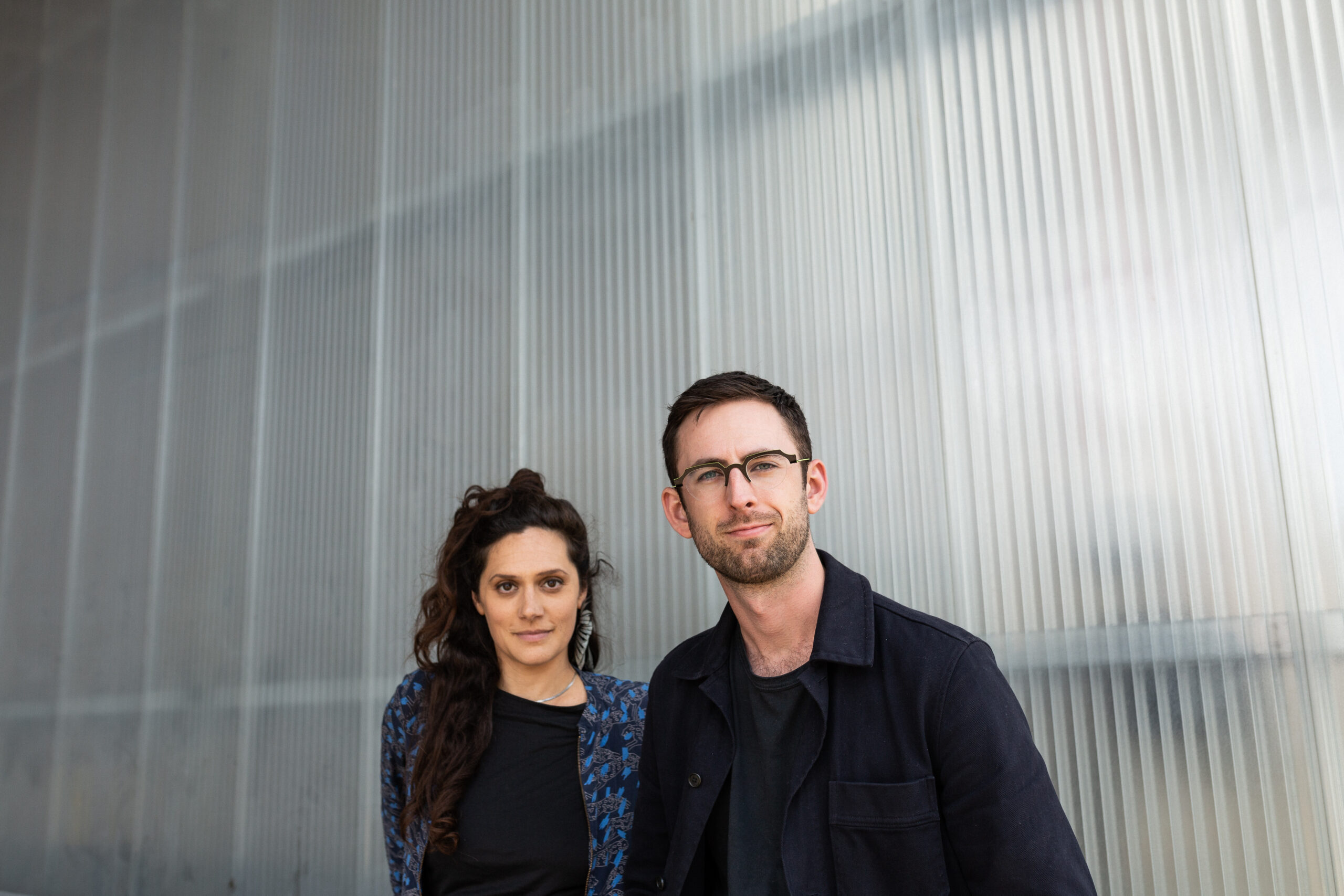
You mentioned the way different spaces artistically inform what you take into the other spaces. With such a busy tour schedule, do you get much of a chance to learn and adapt and get your heads together?
R: “Yeah, very much. Once we’ve done the first couple of nights, then the rest of the tour goes through so many phases. We’re constantly rehearsing. There’s always something to learn from the last show and there’s always something new you have to adapt to for that present show. It really evolves, it’s always growing, it’s never a case of, ‘Oh, we’ve done it now, see you there.’ It’s great to have that opportunity because it’s also quite unusual to get to play things so many times. Some orchestras might rehearse something for one or two days, then play it once and then it’s on to the next thing. We have a longer stretch of time to integrate it and get to a deeper level of interpretation and delivery and everything. That’s very much part of our practice.”
A: “It’s another interesting thing about working across different spaces and with different promoters, that for some of these classical venues, it’s so difficult for them that we might not be able to tell them what the setlist is, for example. Which is crazy because so many of venues will be used for promoting electronic artists and then they won’t even ask for it. They’ll just be like, ‘Cool, yeah, Lyra Pramuk is playing a gig, can’t wait to see it.’ And because we have some violins on the stage, it’s taken a lot of working together and almost training them in what to expect so that they’re not like, ‘But is the Rameau before or after the Vivaldi, what will we put in the programme?!’ And as Rakhi says, a lot of this stuff evolves through the tour: the setlist gets remixed and reshuffled, things drop out, new things come in. But that’s quite unusual in the classical world, for that to be the case.”
Rakhi, you mentioned earlier that Collective is about getting away from the rigidity of traditional ensembles. What is it that differentiates the Collective from that? Who gets involved and what is that process like?
R: “Adam and I do the artistic stuff together: we do the programming, we choose collaborators, and we choose who we want to commission, so we’re the artistic driving force. Then depending on what the projects are, we try and bring in the players we think will be best for those projects. We have a core team of players, but of course, people are freelance and it depends when people are free.”
A: “Non-musicians as well, it might be that we’re working with a director on a thing, or a dancer, or a photographer or something. The fact that it is this flexible structure means that you can really push the boat out on a project if you want, and do a crazy live installation or something. Then the next show could be a chamber orchestra that is much more conventional in the setup. It’s hard for ensembles with a big membership to do that because you’re thinking about how you can make use of the second oboe, you know?”
What is the thing you would say coheres your core group? Do you know how they find working with something that’s so free-flowing and exciting as the Collective versus the more traditional set-ups?
R: “I realised over the last year or so that we’ve created our own little culture. The atmosphere in the office and the management team is very open and supportive, and the same applies in the rehearsal room. I’m shaping and directing it, but there’s room for people to have their own voices. Once people have been in once and they realise that, they’re then part of the family, so hopefully when they come back they feel empowered to contribute as much of themselves as possible. We’ve definitely had feedback that that is the case. It’s quite an open culture. We try and encourage people to give as much of themselves as possible. So in order to do that, they have to also feel safe. So it’s kind of supported and open. But also, like, you know, we’re striving to be as excellent and wonderful as we can. So there’s that sense of kind of discipline as well.
A: “I guess none of that way of working is crazy if you compare it to visual art collectives, but the world of classical music traditionally is so hierarchical. Most of the players that would go into play at an orchestra, they might go in for a week of work and they would literally never say anything for the whole week because it’s not their role. I’m not being glib, it’s like the army. There are like seven squad dudes and then there’s their captain and then there’s that captain’s captain. The guy at the front passes down the orders and everyone falls into line. Not that the way we work is a loose democracy because Rakhi is still ultimately the artistic director and is shaping the work, but it’s quite radical, the amount of collaboration and contribution that happens when you compare it with the ways that large classical ensembles have traditionally worked.”
Rakhi, are you the leading guide on what music to perform or is it a conversation between you both?
R: “Very much a conversation yeah, right from the off. There might be a particular piece that one or both of us loved and then we try and shape something around that work, or if there’s a particular kind of feel or scene we want to create. It’s done very much in collaboration. Inevitably, some of the programmes feel more Adam’s and some more mine but then it’s this lovely kind of overlap.”
A: “That’s nice because then you get the range across the season. Not that we ever made this an official rule, but one of us at least has to be really passionate about a project for it to happen.”
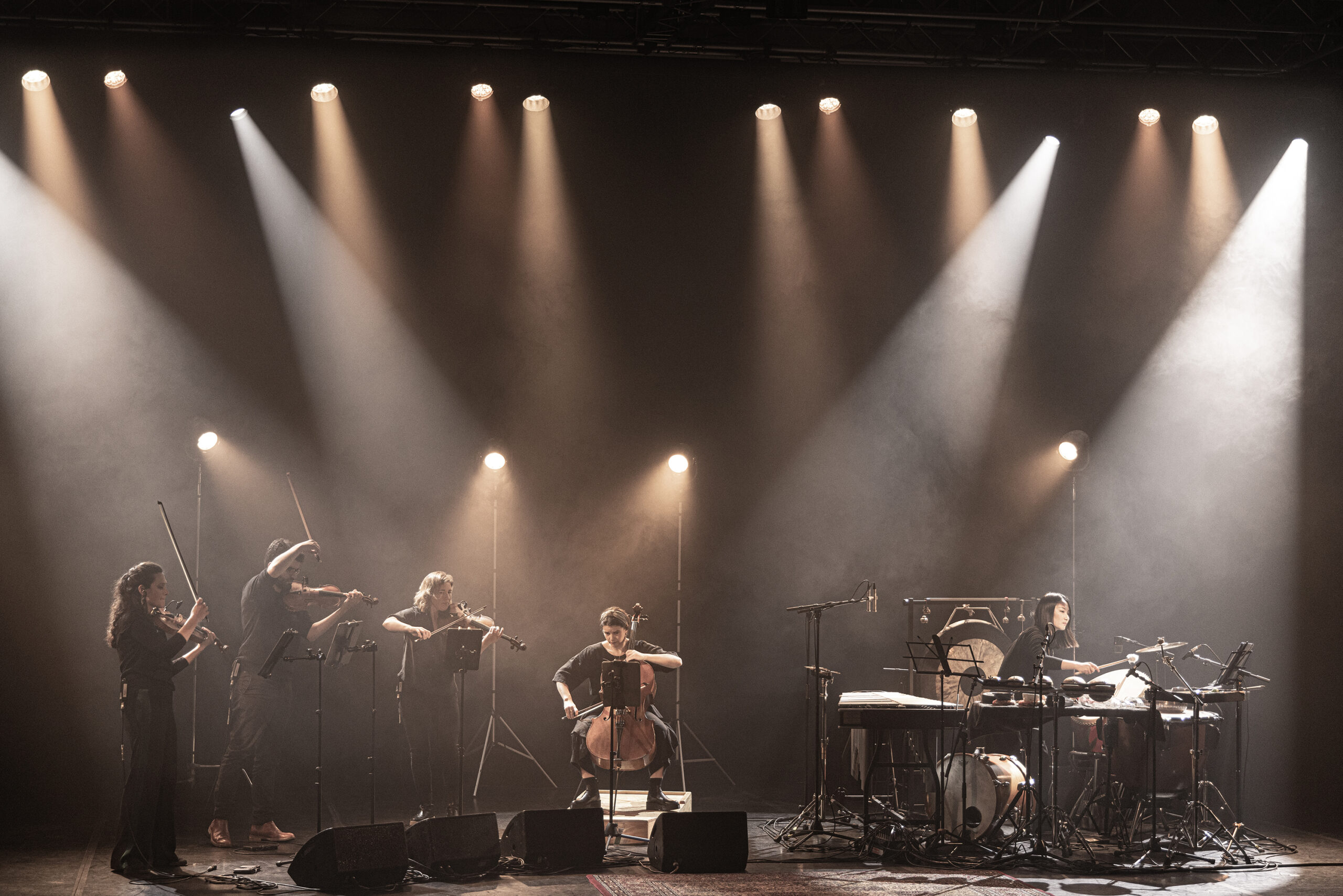
And in terms of the performance for these pieces, do you have that in mind while you’re choosing them? Do the performers have to have that same passion? Some classical performances are so rigid that you can’t read an expression, whereas during Ben Nobuto’s piece, Beibei Wang on percussion looked so into it and I couldn’t see someone with less passion for the piece making it happen.
R: “Yeah, she’s wonderful. Before we did that, we didn’t know Beibei, but since we’ve got to know her, now we’ve got her in mind for future projects and stuff. You have to work with people in some ways even before you properly know what they’re like. Our viola player Ruth [Gibson] did a solo at the Proms and as we grow, we definitely hear pieces like, ‘Oh wow, Nick would sound amazing playing that,’ or so-and-so and that does inform the repertoire we choose.”
A: “We’ve got this Neon show coming up in May and like with that, for example, Seb [Gainsborough, AKA Vessel] had worked with Lyra [Pramuk] before on a remix of one of her new tracks and then she came into our orbit. We went and saw her gig and got to know her a bit and the way that Neon show evolved, that’s a new piece that we’ve commissioned. So it wasn’t that we were like, ‘Ah, yes, there’s this excellent piece of music that will fit beautifully into this programme.’ It was like, ‘Well, we really love her and we really love her stuff, so what can we build that will be a really nice set that this thing will really flourish in? Same with Hannah Peel. We commissioned that last year, Neon, the piece that the programme gets its name from. Whenever you’re commissioning new work, inevitably, it is about the person and about the respect that you have for their work. Maybe their work has a really strong vibe in one direction or another and that’s what you’re going off when you’re finding other things to put with it or other collaborators to bring in on the project.”
When you commission a work, is there a mandate where is has to hit certain beats? Are you very involved with the process of the development of the work?
R: “It’s generally a time limit, we don’t tend to get so artistically involved. The composers know the context in which their work will be showed in. Lyra was very interested in what else is in the programme and how her work might fit within that. Some of Seb’s stuff is quite industrial and part of a programme called Heavy Metal; it didn’t end up being very loud and noisy but that was nice to bring a different side of things. When people are composing, they don’t even know what’s going to come out to begin with. You have to give them that artistic license and freedom, a lot of it’s based on trust.”
A: “We’ll give them instrumentation always. We might say that in this show, this is the total toys you have to play with and then you can use any combination. Even though a show might involve seven musicians, electronics, and whatever else, they might write a piece for modular synthesizer, vibraphone and flute. Time is the other one.”
What is it you think composers (particularly crossover artists) gain from this way of working, where you’re commissioning them as opposed to them developing a solo album with a label?
R: “It’s a new place for people to explore and they know that we really want to do it. Sometimes people get commissioned and it’s the token contemporary thing in the concert, they spend half an hour rehearsing it, they play it, and it’s never thought of again, and no one likes it. And it’s like, no wonder! We really care about bringing something to life for these people because music is a language, and it’ll be a new form of language.”
A: “Yeah, I think the restrictions are quite helpful as well, creatively. If you’re a producer and you’re working on your next record, then potentially that task is super open and takes years, it could be all of these different things. I think it’s a different, quite interesting artistic challenge to say we’d like a piece that is for this specific line-up of artists, we’d like it to involve a dancer, and we’d like it to be a setting of this poem or something. It’s almost like a puzzle or an artistic scenario that they have to solve. It’s very rare for the solo artist to have that opportunity because most of the time they’re coming up with all of this stuff. If you look back at the history of music, it’s just wall-to-wall artists setting creative briefs for themselves: people are limiting themselves to the use of this many notes, or they have to be in this order, or even dada, which is total chaos, they’re still coming up with structures like taking stuff out of a hat or jumbling up words to come up with a new poem or something. Certainly to date, we’ve never really had feedback that that’s felt like a limiting thing. Actually, sometimes it’s been the opposite. With Neon, for example, very early on in the process, this idea of neon came up and that’s quite a specific artistic direction to go in, to be thinking about neon lights and what does that make you think of? Urban landscapes and nocturnal stuff, seedy underground neon signs. But then that sparked all of this crazy stuff in Hannah, she ended up using field recordings from Shinjuku Station, Tokyo. The whole thing took on this whole life that just started with this quite simple creative concept.”
I’m looking forward to the Neon show, and in terms of the music that the commission’s next to, there’s Julius Eastman’s Joy Boy in the programme. It’s been interesting seeing a composer who was so marginalised by the music community then be embraced by it once he’d passed away, once he’d undergone all of these hardships. We’re seeing more of his music performed now, though not necessarily usually Joy Boy. How much would you say Manchester Collective is a reflection of contemporary music environments and how much of it is a response? Is it just timeliness or do you see yourselves as intervening in today’s musical environment?
R: “I talk with Seb, my partner, and we have really interesting discussions about music. He pointed out to me by just the fact of what we do, it’s not intended to be political but because we’re forging our own path and doing what we want, it ends up having an almost political agenda. Because you’re being rebellious, not for want of causing trouble, it’s more just wanting to do what you want. By doing that, you’re saying you don’t like the way things are done, which might cause people offence, but that’s not the point, it’s more like liberation for us.”
A: “In the 20th century, I think classical music has been very, very disconnected from popular culture and from zeitgeisty stuff about what’s going on in the world. It’s felt almost like a completely separate academic field. If you look at theatre or visual art, even dance, there’s always this constant feedback loop of what’s happening in the world. Playwrights are screenwriters writing it out. And then the culture influences what’s happening in the world and it’s this cycle. It’s felt like classical music has always been outside of that, almost like a focus on presenting museum work from the past, you’re recreating something from long ago rather than making something that is intended to engage with culture. I still don’t think that we’re necessarily working in the way that a theatre company would in terms of devising new work, but certainly I think we’re maybe this little connecting link between large parts of the classical music sector and other art forms that are super, super engaged. By no means is it only us, there are other organisations in music who are doing similar work and really exciting work, but I can see that this cohort of new alternative classical organisations is moving the dial on what the big orchestras and big festivals are programming. That change is happening. Eastman is a really good example. Eastman being slowly more embraced by, I wouldn’t say mainstream, but at least a slightly more broad classical world, that didn’t start with the BBC Symphony Orchestra being like, ‘Oh, yes, we’re gonna play some Julius Eastman this year,’ it started off with like Apartment House, and then Oto and us, and then all of these slightly left-of-centre people. The cool challenge with Eastman is that most of that hasn’t been recorded, and many of the recordings that exist are horrible. So it’s quite rare with work that already exists and it’s a composer that is no longer with us. It’s quite rare, when you’re playing his music, you’re really actively engaged in the process of shaping what that canon looks like. Because the recordings that you make or the performances you give, those interpretations can be quite influential, because no one’s heard some of this work before. It’s through that process of repeated performance with lots of different ensembles getting in on that action, that’s how a performance practice is developed with any composer. So that’s kind of exciting. We do that a lot with living composers, but it’s quite unusual for us to have the opportunity to do that with a composer that we’re not actually commissioning.”
R: “Yeah, remember when we first met the White Hotel guys? Chris said then, ‘Maybe you can play some Eastman or something,’ and that was five or six years ago. So it was funny when we played at the Proms, ‘Ooh, first time it’s been played at the Proms,’ it’s like, well, he has been around a little while.”
Just touching on interpreting the work as well, that’s something you do a lot with living composers developing new works. Can you tell me about what that process is like?
A: “I mean, we’re a young organisation, so it takes the piss to say that it’s a long collaboration, but for us a long collaboration with Edmund Finnis. He’s someone that we are in a constant process of him making new work for us, then us figuring that out and performing it and recording it. One of the first things we did of his was commissioning a work for string ensemble called “The Centre is Everywhere”, which was subsequently released on Bedroom Community. Recording is so important because no matter how exciting this stuff is, if it doesn’t exist in some kind of a recorded format, then no one ever plays it, we don’t know it exists. There are very few musicians who can pick up a score and hear it in their heads like Mozart. You need something to grab onto. We know that that recording is now a really important touchstone in the understanding of his music in the broader musical world. And that piece, since we played it at Proms, that’s now being played by BBC Philharmonic Orchestra, 12 Ensemble are doing it at Kings Place next week, City of London Symphony have played it, Scottish Ensemble played it, it’s been done at the academies, the conservatoires, you know? This is one micro-example of how this happens, but it does take a group. And we’ve done this in reverse with other groups where 12 Ensemble made this great recording of an older [Oliver] Leith piece called Honey Siren, and that recording is what has enabled other groups all over the world to be like, ‘Oh, shit, this is damn cool, let’s play it on tour.’ We’ve now commissioned Oliver, we’re premiering a string orchestra piece of his at the Southbank in October. That’s the really exciting bit, when you feel like there is a scene, there’s this really exciting dialogue and collaboration going across all sorts of different ensembles or solo artists. Seb’s a great example, his is a very different musical world to ours, but I think our work has informed his own writing, and his work has certainly informed our performance practice.”
I really like the idea that recording something can give music a new lease of life or essentially birth it. Whereas I know that there are people who hold the line of thought that music is best live and when you record something, it deadens the sound in a way. And you’ve been continuing recording – it might not be the main focus of the Collective but it’s obviously part of your calendar. How different is it as a process compared to your bread and butter, which is the performance of the music in live spaces?
R: “We’d made our first album just before and then released it during the pandemic. It became quite obvious to us that having a recorded catalogue is really important, because lots of people are not gonna be able to come to your shows but that doesn’t mean you still can’t share your artistic dialogue with them. Adam produces them and our sound guys in Manchester are very close collaborators with us. They think a lot about the different type of sounds they want to create for the different repertoire, the different works, sometimes it’s in close, sometimes it’s out, far away, but I think even for them, it’s been quite an exciting process. Brendan [Williams] starts to let his imagination go wild with how he can record us and it becomes another side of our collaboration. It feels really important to keep putting stuff out, a lot of that will be commissions and then some might be newer versions of repertoire that’s out there already. But yeah, we’re gonna keep churning them out.”
A: “We’ve just made our first record with a classical label called BIS. But for the first three records that have been released, apart for the musicians, obviously, the entire creative team – producers, mastering engineers, label – have all been from a contemporary music world. That’s been really influential and interesting for us, the fact our recording engineer mixes records for Blue Note and does weird, heavy electronica, jazz stuff, it’s a very different artistic sensibility that’s quite freeing because (I mean, this is the same story with everything but) traditionally, classical recording is very, very rigid in structure. You’re trying to exactly recreate the sound of the music in the room, which hasn’t really been a priority for us at all, actually.”
What are the music scenes you’re interacting with just generally as individuals?
R: “Well, right now, I’m quite into Bolivian music because Seb and I went to Argentina last month and we came back learning all of these songs, trying to sing along in pidgin Spanish and Inca language. That’s the phase at the moment, which is quite fun.”
A: “I’ve never been someone who’s super embedded in a specific scene, and I’m including the classical world in that. I certainly don’t really listen to a lot of classical music in my own time. I grew up with two classical musician parents, a cellist and a pianist, so it’s been a really fun thing for me through my 20s that I had these huge gaps in my listening, you know? I was always pretty up with new stuff but the records that most people grew up with because their parents were into it, like the Stones, Beatles, Bob Dylan or whatever, I just never heard any of that stuff in my childhood. That’s been quite fun, over the last 10-15 years, filling in those gaps. I tend to be really into anything that creates an immediate physical or emotional reaction in me. So that can be really, really heavy electronic-y stuff. I’ve started listening to a bit of metal. But also, contemporary classical music that is strange. I’m always attracted to music that is unexpected, I suppose. I like to be surprised. I got really obsessed with Anna von Hausswolff, who we’ve actually commissioned. She’s gonna write a piece for us. She’s an organist, she plays the church organ. But really sort of sludgy… She has records that are literally just church organ tracks that she’s written, but then she plays with the band as well. That’s an example of what I get most excited about, none of those musical worlds are traditionally hanging out together. Black metal-y, sludgy, doomy organ music-y new classical. She got approached by the New York Times recently because one of her shows in France got picketed by Catholics, because they were like, ‘she’s worshipping the devil,’ which I mean, she’s completely not. It’s just that church organs are found in churches, so that’s where these gigs were. But yeah, I think often when you get musicians who are just ploughing their own furrow, and actually, the irony is that when they’re not that engaged in what’s going on around them, then you end up with really, really original work. And I think that’s the case with Rakhi, and with many of our collaborators, they’re quite fiercely just doing the thing that they do. And that’s what Lyra is like, that’s what Ed Finnis is like, they’re not really reacting to musical trends so much. They’re just like, ‘Yeah, this is the thing that I was dreaming of when I was 15, and it’s the thing that I’m now really fucking good at doing.’ The musical world around them has changed like 500 times over the course of their lives, but they’re refining this beautiful, specific, really interesting thing. So if we can hack into that a bit, then that’s always really exciting.”
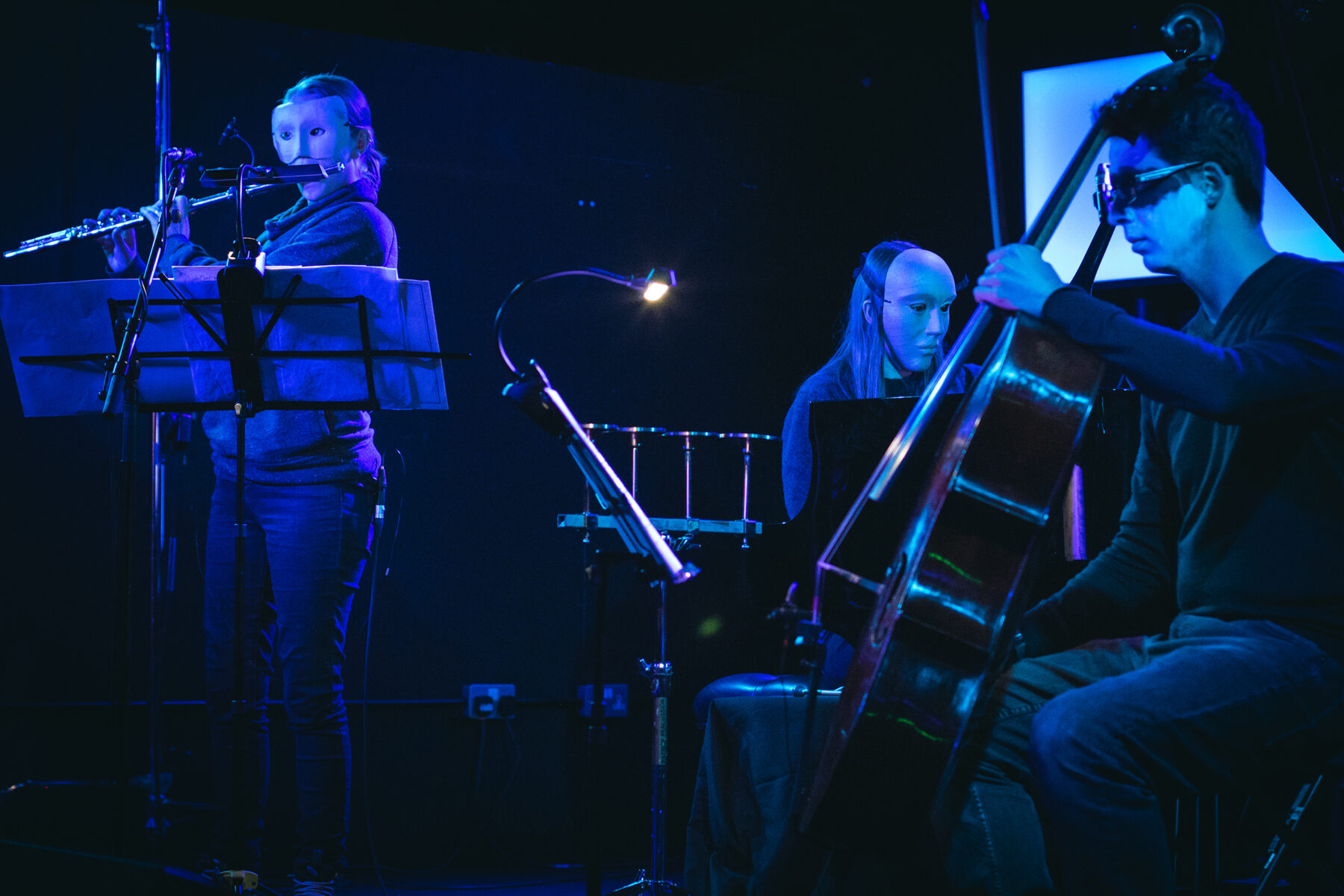
Rakhi, you’re playing the roles of artistic director, on-stage performer, and a composer of recorded music in your own right. How much do these elements inform each other?
R: “There’s always overspill. It’s hard to know where one thing starts and one thing ends. Especially when it comes to collaboration and performance practice because, you know, working with Abel this week, I absorbed so much of how he plays and what his musical language is. And then I find myself putting that into Vivaldi. A lot of this happens, I think, subconsciously. That probably feeds into the music that I write, when I manage to find some space to write anything. All of this stuff is interlinked, but in order to do anything well, you have to focus on one thing at one time. So I’m not doing a rehearsal and coming home and trying to write some music. If I’m doing a project, I’m doing a project. And there’s the preparation up to that. Otherwise, you’re spinning too many plates, I find. That’s general life organisation, I suppose, which we all have to negotiate and navigate.”
You mentioned marking the fifth anniversary last year. Six years in, what would you say the main lessons that you’ve both picked up from running the Collective are?
A: “We are now really fortunately in a position where often we can pick up the phone and talk to a really exciting artist, and they’ll be basically up for making something, so that’s nice. I feel like my job and the job of our team is basically to create the right environment for those artists to be able to be as creative as possible and to do their thing as well as they possibly can. And then to get that out to the widest possible audience. I suppose with most solo acts, there’s this really big infrastructure of managers and bookers and record labels and publishing and we had most of that in-house. We work with a label but our team are doing all of those different jobs, promotion, PR and whatever, but ultimately I think that’s the gig for us. Often, it’s about time, carving out enough time for composers or for performers to be in the room, to have mental space, to pay them enough that they can afford to just not worry about needing to do another thing so they can pay the rent that month. That’s also a part of it, that’s a financial luxury that you have to focus on a creative task at a time. Yeah, it feels like that’s the job. I don’t know that that’s really changed much, but it will be very easy for us to take on twice as much as we do. That’s been quite a big learning, to stay focused and just keep that space for the artist to do what they do. Because so much commissioning is just a complete fucking waste of time. If it’s going to be good, then that space is really important. I don’t know, Rakhi, what do you think?”
R: “Yeah, similar. I don’t think I know many organisations that are coming around to the idea of how close creativity is to chaos. One thing Adam and I are continually evolving and learning is that space of, it’s okay to not know, but you can have a trust in the not-knowing. We both know that we excel in what we do, so we trust that we will get to that place. That period of not knowing can be quite painful, but we’ve done it quite a few times now. We’ve done it enough times to know that it’s part of the process, if you’re really stretching and developing, then there’ll be moments in probably all aspects of the work, from the managerial, strategic side to me preparing what actually happens in room, it’s interesting how these notions can feed into every part of the organisation. But by recognising that, it means that there’s such a wider potential, I think. But it’s quite scary sometimes.”
It sounds like you’re quite battle hardened at this point. But yeah, the idea of the unknown and that uncertainty…
A: “All of this is a spectrum, you know? So we get a lot of rehearsal time compared to the classical world, but it’s still very, very short development time when you compare it to theatre, visual art, dance or whatever, where they might spend six weeks rehearsing for a thing. Often, that’s the bit where you just really have to be gutsy. You’re walking in on a Monday, you know that on the Thursday you’re playing a gig at the Bridgewater, and that the work just genuinely does not exist yet. You have to be ready that it’s not going to be what you expect, inevitably. I literally rewrote all of our programme for this tour last night because for a year, we’d say, ‘Yep, this is the show, this concept. It’s gonna be great,’ and then after three days of rehearsal, no, no, no. So that flexibility, you have to be up for that.”
R: “I think a lot of groups don’t know that you can exist in that space, it’s like, ‘You make your programme, you’ve got to stick to your programme.’ And we do stick to the programmes, there’s just that last moment of magic. You know, you’re doing the 100 meters to find this thing, the thing of the moment. A lot of groups have actually never dared to go to that place. I’m not saying that to big ourselves up, but because of these practicalities, you know, the programmes have to be decided a year in advance and then 12 hours to put it together, you’ve got a group of 16 musicians, one person at the front, and then that’s all you can do with those prospects. But somehow, we’ve learned that we just want to go that bit further.”
A: “It is very difficult though, and it does create quite significant tensions in our planning, it’s really hard working with funders in that way, because funders fucking hate that. They want to know what it is that they’re going to get. If someone’s coming in to co-commission a thing, they want to know what it is that they’re in for. It feels like we’re really figuring this all out with presenters as well. We’re really lucky that we had this residency at the Southbank and they have been really supportive both institutionally and financially in the commissioning of some of these big projects that are coming up. But it’s hard for them as well, because if someone gives you however much money, it feels tough to turn around and be like, ‘Ah, sorry, we don’t really know that yet, but I promise it will be good!’ Because they want to be like, ‘Who are the collaborators? How long is it? What lights do you need?’ And for us, well, we’ll know when we know.”
R: “You’re very good with dealing with that, Adam. And I’m learning to try and make your life easier as much as possible.”
A: “It has to be a middle, I guess, because you need some parameters. But yeah, that chaos is really fun. That’s the thing, when you go to an underground venue or a weird art intervention, the joy of that is that it feels spontaneous and chaotic. The White Hotel came onto our radar five years ago because they put on this show, they restaged the funeral of Princess Diana at this ex-M.O.T. garage in Salford. They had a hearse and they paraded through the streets of Salford and there was a mariachi band and a guy that was reciting the bit that the Archbishop of Canterbury got out or whatever. That whole thing came together in the 12 hours before the happening. If it’s going to be that kind of really subversive intervention, then you can’t just neatly structure that out 18 months before and be like, ‘Oh, yes, we’re going to do this crazy intervention next November.'”
Manchester Collective are touring their new programme Neon across the UK throughout May 2022. Find out more and book tickets here.
Photo credits (top-bottom): Robin Clewley, César Vásquez Altamirano, Robin Clewley, Alan Kerr, Lucy McLachlan.
Manchester Collective: Website, Instagram, Bandcamp, Youtube, Twitter, Facebook

